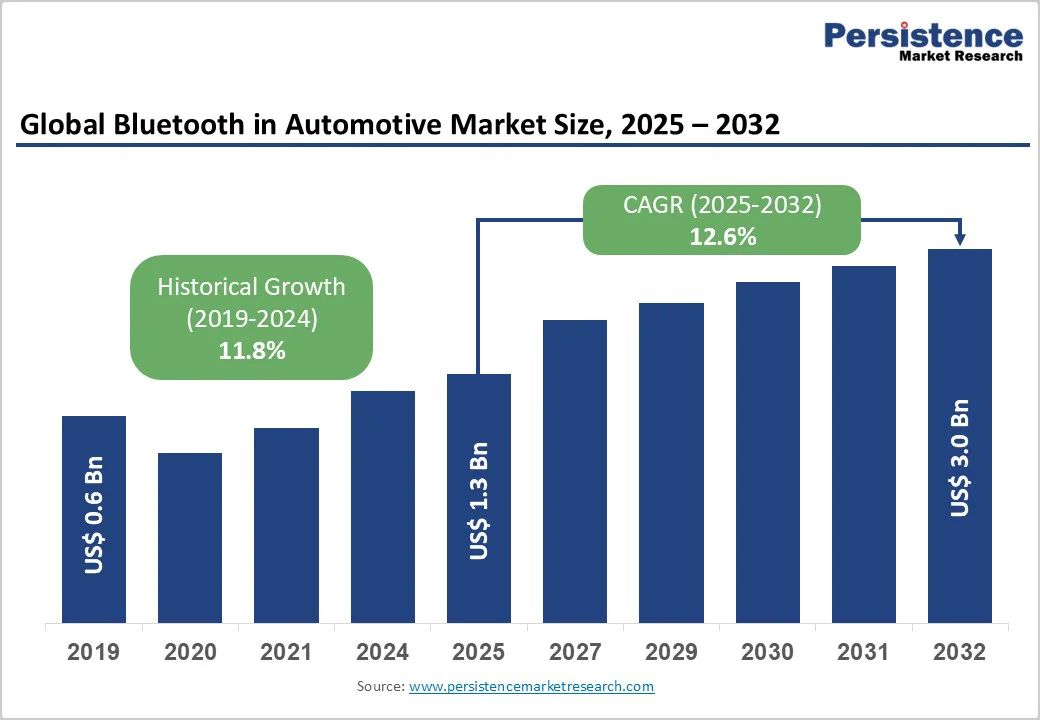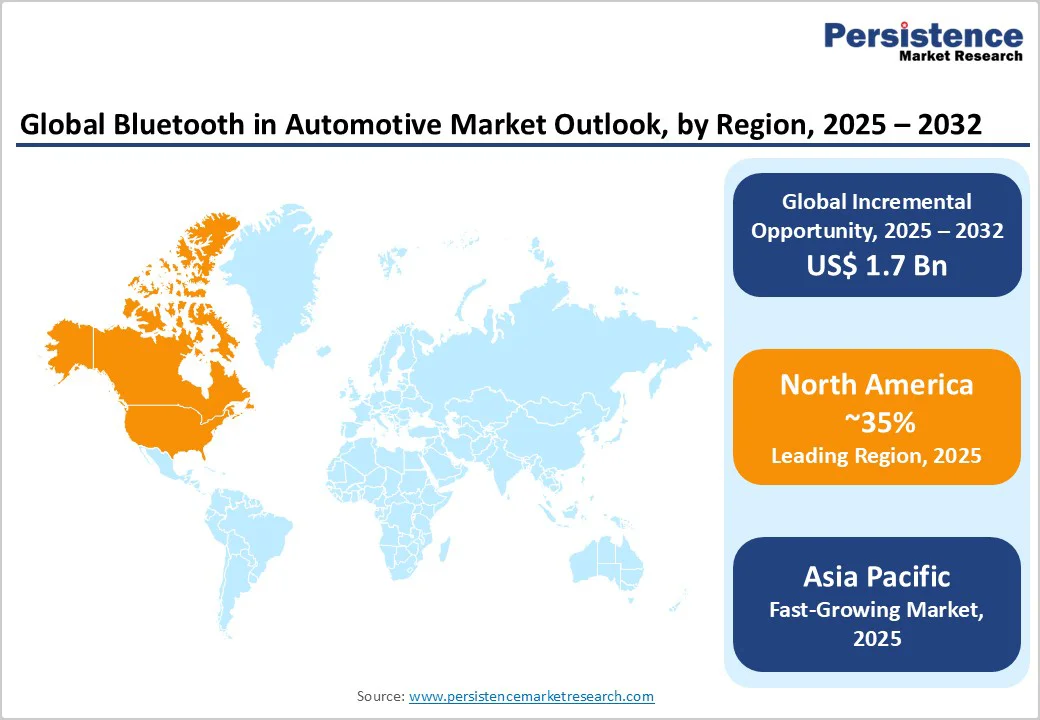ID: PMRREP12046| 195 Pages | 14 Nov 2025 | Format: PDF, Excel, PPT* | Automotive & Transportation

The global bluetooth in automotive market size is likely to be valued US$1.3 Billion in 2025, projected to US$3.0 Billion by 2032, growing at a CAGR of 12.6% during the forecast period from 2025 to 2032, driven by the increasing integration of connected vehicle technologies, rising demand for seamless infotainment systems, and advancements in wireless communication. The need for hands-free communication and enhanced driver safety, particularly in passenger cars, has significantly boosted the adoption of bluetooth in automotive across various demographics. The market is further propelled by innovations in low-latency bluetooth modules and telematics integration, catering to preferences for smart and efficient connectivity. The growing acceptance of bluetooth in automotive as a standard feature in modern vehicles, particularly for OEM installations, is a key growth factor.
| Key Insights | Details |
|---|---|
| Bluetooth in Automotive Market Size (2025E) | US$1.3 Bn |
| Market Value Forecast (2032F) | US$3.0 Bn |
| Projected Growth (CAGR 2025 to 2032) | 12.6% |
| Historical Market Growth (CAGR 2019 to 2024) | 11.8% |

Rising Prevalence of Connected Vehicles and Demand for Seamless Connectivity
The increasing prevalence of connected vehicles globally is a primary driver of the Bluetooth in Automotive Market. Connected cars are expected to reach 500 million units by 2030, with bluetooth enabling wireless integration. This widespread adoption creates a substantial demand for reliable bluetooth solutions. Bluetooth in automotive offers low-latency communication, typically faster than wired alternatives, making it ideal for infotainment and telematics. This is particularly critical for features requiring real-time data, such as hands-free calling.
The growing adoption of bluetooth modules, such as those from Qualcomm Technologies Inc., has gained traction due to proven reliability in trials, with over 80% user satisfaction in connectivity. The rise in EV adoption and the increasing availability of bluetooth-enabled systems in OEMs have boosted access, further driving market expansion. The surge in demand for wireless systems, coupled with innovations in low-energy bluetooth, continues to propel the market forward, particularly in developed regions with advanced automotive industries.
High Integration and Compatibility Costs
The high costs associated with integration and compatibility of bluetooth in automotive pose a significant restraint on market growth. Developing bluetooth systems requires advanced wireless technologies, rigorous testing, and seamless integration with vehicle electronics. These processes involve substantial financial investment, often exceeding millions of dollars, which can be a barrier for smaller manufacturers.
Regulatory bodies impose stringent requirements for electromagnetic compatibility and safety. Compliance increases costs and timelines. For instance, embedding bluetooth in telematics can take years, with costs escalating due to interoperability challenges. Smaller firms struggle against players Panasonic Corporation and Harman International. Furthermore, complexity of multi-device pairing adds to development burdens, which can deter innovation in cost-sensitive regions.
Advancements in Low-Energy Bluetooth and Telematics Integration
Advancements in low-energy bluetooth and telematics integration are creating substantial growth opportunities in the automotive market. Low-energy Bluetooth technology minimizes power consumption, making it ideal for battery-efficient electric vehicles (EVs) and supporting sustainable mobility goals. This innovation meets the rising demand for energy-efficient, always-connected systems. Telematics integration enhances real-time data sharing by combining Bluetooth with cloud-based platforms, enabling advanced functions such as predictive maintenance, remote diagnostics, and improved fleet management.
For example, companies Qualcomm Technologies Inc. and Intel Technologies are investing in R&D for low-energy modules combining wireless with AI diagnostics. These reduce timelines via modular protocols. Furthermore, smart pairing integration enhances efficiency. As demand for connected mobility grows, these drive expansion in regions such as Asia Pacific and North America.
Product Type Insights
Passenger Cars dominates the market, accounting for 70% of the share in 2025. Its dominance is driven by high volume, versatility, and consumer demand for infotainment. Passenger cars, such as those equipped by LG Electronics Inc., provide seamless streaming, ensuring compatibility. Its connectivity and features make it preferred for daily use.
Commercial Vehicles is the fastest-growing segment, driven by fleet telematics and increasing adoption in logistics. Commercial vehicles offer durability, appealing for tracking. Focus on integration accelerates adoption in Asia Pacific and Europe.
Application Insights
Infotainment leads the with a 45% share in 2025, driven by rising consumer demand for in-car entertainment and seamless streaming access. Its widespread use in music, navigation, and smartphone connectivity enhances driving convenience. Growing preference for interactive, connected experiences continues to strengthen the dominance of infotainment systems globally.
Telematics segment is the fastest-growing, propelled by rising demand for real-time location tracking and fleet management solutions. The ability to monitor vehicle performance, enhance safety, and optimize logistics through connected systems boosts adoption. Bluetooth-enabled telematics offers seamless data transmission, improving operational efficiency and driving market expansion.
Sales Channel Insights
OEMs dominate the market with nearly 60% share in 2025, driven by extensive factory integration and strong partnerships with automakers. Their ability to embed Bluetooth seamlessly into new vehicles ensures reliability, performance, and enhanced user experience, making OEM-installed systems the preferred choice over aftermarket alternatives for modern car buyers.
The aftermarket segment is witnessing rapid growth, driven by rising consumer demand for vehicle upgrades and retrofit solutions. The ease of integrating Bluetooth-enabled add-ons, such as hands-free kits and infotainment systems, enhances user convenience and personalization. Growing interest in affordable, customizable connectivity solutions continues to accelerate aftermarket adoption across various vehicle categories.

North America Bluetooth in Automotive Market Trends
North America is projected to account for nearly 35% of the global bluetooth in automotive market in 2025, driven by high vehicle production and connectivity in the U.S. The U.S. market is characterized by robust R&D activities, with companies such as Harman International leading innovations in infotainment bluetooth. The high adoption of connected cars, coupled with strong consumer spending, fuels demand for wireless features.
The growing integration of Bluetooth technology in electric vehicles (EVs) and the widespread availability of OEM Bluetooth systems in retail channels are key factors propelling market growth in the U.S. The increasing demand for advanced in-car connectivity, hands-free communication, and infotainment features aligns with the nation’s accelerating EV adoption. The integration of Bluetooth in navigation, diagnostics, and safety systems enhances driving convenience and efficiency.
Europe Bluetooth in Automotive Market Trends
Europe is a significant player in the bluetooth in automotive market, supported by strong regulatory frameworks and collaborative research initiatives. Leading countries such as Germany, France, and the UK are driving market growth through investments in wireless innovation and increasing awareness of connected mobility. The European standards support the development of advanced bluetooth modules, with companies such as Sony Corporation focusing on low-energy systems.
The rapid adoption of electric vehicles (EVs), particularly in Western Europe, is fueling demand for advanced infotainment, navigation, and hands-free communication systems that rely on bluetooth technology. Additionally, Europe’s strict focus on data privacy, cybersecurity, and eco-friendly connectivity solutions aligns with its broader sustainability goals, fostering consumer trust and technological reliability.
Asia Pacific Bluetooth in Automotive Market Trends
Asia Pacific is the fastest-growing market for bluetooth in automotive, driven by rapid industrialization, expanding vehicle production, and rising disposable incomes in key economies such as China and India. China remains at the forefront, with major investments from companies such as Samsung Electronics Co. Ltd. aimed at developing cost-effective and high-performance infotainment systems that enhance in-vehicle connectivity. India’s automotive market is witnessing a surge in connected vehicle infrastructure and increasing adoption of smart features, particularly in urban centers, where consumer preference for comfort, safety, and convenience is growing.
Government initiatives to promote digitalization and intelligent transportation systems are also boosting the integration of Bluetooth technology in vehicles. The growing popularity of telematics, navigation, and hands-free communication features in passenger cars further supports market expansion. As automotive OEMs focus on offering advanced infotainment and connectivity solutions, the Asia Pacific region is expected to remain a crucial hub for innovation and production in the global automotive Bluetooth industry over the coming years.

The global bluetooth in automotive market is highly competitive, characterized by a mix of global electronics giants and specialized tech firms. In developed regions North America and Europe, large players such as Panasonic Corporation, Harman International, and Qualcomm Technologies Inc. dominate through advanced R&D capabilities and established supply chains.
In the Asia Pacific, regional players such as Samsung Electronics Co. Ltd. are gaining traction by offering cost-effective solutions tailored to local markets. Companies are focusing on product innovation, such as low-energy and telematics integration, to gain a competitive edge. Strategic partnerships, acquisitions, and investments in wireless technologies are further intensifying the competitive landscape.
Key Industry Developments
The global bluetooth in automotive market is projected to reach US$1.3 Billion in 2025.
The rising prevalence of connected vehicles and demand for seamless connectivity are key drivers.
The market is poised to witness a CAGR of 12.6% from 2025 to 2032.
Advancements in low-energy bluetooth and telematics integration are key opportunities.
Panasonic Corporation, Harman International, Qualcomm Technologies Inc., Samsung Electronics Co. Ltd., and Sony Corporation are key players.
| Report Attribute | Details |
|---|---|
| Historical Data/Actuals | 2019 – 2024 |
| Forecast Period | 2025 – 2032 |
| Market Analysis | Value: US$ Bn |
| Geographical Coverage |
|
| Segmental Coverage |
|
| Competitive Analysis |
|
| Report Highlights |
|
By Vehicle Type
By Application
By Sales Channel
By Region
Delivery Timelines
For more information on this report and its delivery timelines please get in touch with our sales team.
About Author